
Kickboxing is a full-contact hybrid martial art and boxing type based on punching and kicking. Kickboxing originated in the 1950s to 1970s. The fight takes place in a boxing ring, normally with boxing gloves, mouth guards, shorts, and bare feet to favor the use of kicks. Kickboxing is practiced for self-defense, general fitness, or for competition. Some styles of kickboxing include: Full contact karate, Muay Thai, Japanese kickboxing, Lethwei, Sanda, and Savate.

A kick is a physical strike using the leg, in unison usually with an area of the knee or lower using the foot, heel, tibia (shin), ball of the foot, blade of the foot, toes or knee. This type of attack is used frequently by hooved animals as well as humans in the context of stand-up fighting. Kicks play a significant role in many forms of martial arts, such as capoeira, kalaripayattu, karate, kickboxing, kung fu, wing chun, MMA, Muay Thai, pankration, pradal serey, savate, sikaran, silat, taekwondo, vovinam, and Yaw-Yan. Kicks are a universal act of aggression among humans.

Muay Thai, sometimes referred to as Thai boxing, is a Thai martial art and full-contact combat sport that uses stand-up striking, sweeps, and various clinching techniques. This discipline is known as the "Art of eight limbs", as it is characterised by the combined use of fists, elbows, knees and shins. Muay Thai became widespread internationally in the late 20th to 21st century, when Westernised practitioners from Thailand began competing in kickboxing and mixed-rules matches as well as matches under Muay Thai rules around the world. The professional league is governed by The Professional Boxing Association of Thailand (P.A.T.), sanctioned by The Sports Authority of Thailand (S.A.T.).

A strike is a directed, forceful physical attack with either a part of the human body or with a handheld object, intended to cause blunt or penetrating trauma upon an opponent.
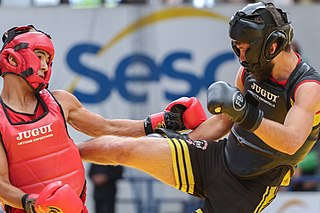
Sanda, formerly Sanshou, is the official Chinese boxing full-contact combat sport. Sanda is a fighting system which was originally developed by the Chinese military based upon the study and practices of traditional Chinese martial arts and modern combat fighting techniques; it combines boxing and full-contact kickboxing, which includes close range and rapid successive punches and kicks, with wrestling, takedowns, throws, sweeps, kick catches, and in some competitions, even elbow and knee strikes.
Strikes can be offensive moves in professional wrestling, that can sometimes be used to set up an opponent for a hold or for a throw. There are a wide variety of strikes in pro wrestling, and many are known by several different names. Professional wrestlers frequently give their finishers new names. Occasionally, these names become popular and are used regardless of the wrestler performing the technique.
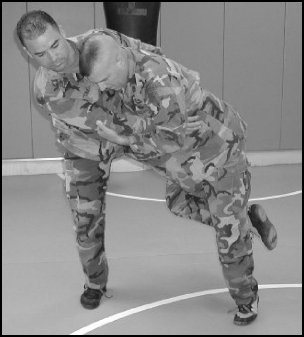
In martial arts and combat sports, a takedown is a technique that involves off-balancing an opponent and bringing them to the ground with the attacker landing on top. The process of quickly advancing on an opponent and attempting a takedown is known as shooting for a takedown, or simply shooting. Takedowns are usually distinguished from throws by amplitude and impact, where the purpose of a throw is to outright eliminate the opponent while purpose of a takedown is to bring the opponent down on the ground, assume a dominant position and then proceed to finish them with jointlocks, chokeholds, or ground and pound.
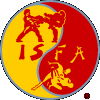
Shootfighting is a martial art and combat sport, with competitions governed by the International Shootfighting Association (ISFA). It incorporates techniques from a multitude of traditional martial arts, the most principal of these being wrestling and kenpo.

The front kick in martial arts is a kick executed by lifting the knee straight forward, while keeping the foot and shin either hanging freely or pulled to the hip, and then straightening the leg in front of the practitioner and striking the target area. It is desirable to retract the leg immediately after delivering the kick, to avoid the opponent trying to grapple the leg and to return to stable fighting stance.
A leglock is a joint lock that is directed at joints of the leg such as the ankle, knee or hip joint. A leglock which is directed at joints in the foot is sometimes referred to as a foot lock and a lock at the hip as a hip lock. Leglocks are featured, with various levels of restrictions, in combat sports and martial arts such as Sambo, Brazilian Jiu-Jitsu, catch wrestling, mixed martial arts, Shootwrestling and submission wrestling, but are banned in some sports featuring joint locks such as judo. The technique has been seen across a wide range of different combat sports and is reportedly over 2,500 years old, having been seen in the lost art of Pankration in the original Olympic Games.
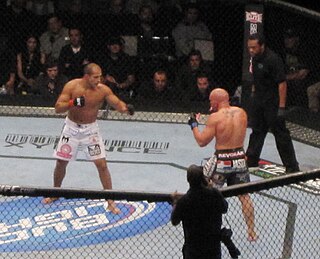
In martial arts and combat sports, stand-up fighting is hand-to-hand combat between opponents in a standing position, as distinguished from ground fighting. Clinch fighting is stand-up grappling. Fighters employ striking, including striking combinations, using either body parts or mêlée weapons, to incapacitate or injure the opponent. Combatants use blocking techniques to block the opponent's attacks.
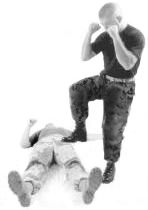
A downed opponent is a combatant that is on the ground, as compared to a combatant that is in a standing position. This commonly implies that the downed combatant is lying on the ground, but can technically refer to any position in which anything except the soles of the combatants feet are touching the ground. In many combat sports featuring striking, such as boxing or taekwondo, it is illegal to strike a downed opponent. The referee will promptly bring the downed opponent to his or her feet to resume the bout standing. The only combat sport which allows strikes when the opponent is down is mixed martial arts. The majority of MMA organizations follows the common rule of prohibiting knee strikes and kicks to the head of a grounded opponent, but fighters are allowed to strike their opponent's body. Hand and elbows strikes to the head are considered legal.

A knee strike is a strike with the knee, either with the kneecap or the surrounding area. Kneeing is a disallowed practice in many combat sports, especially to the head of a downed opponent. Styles such as kickboxing and several mixed martial arts organizations allow kneeing depending on the positioning of the fighters. Knee strikes are native to the traditional Southeast Asian martial arts and traditional Okinawan martial arts.

Clinch fighting or trapping is the part of stand-up fighting where the combatants are grappling in a clinch, typically using clinch holds. Clinching the opponent can be used to eliminate the opponent's effective usage of some kicks, punches, and melee weapons. The clinch can also be used as a medium to switch from stand-up fighting to ground fighting by using takedowns, throws or sweeps.
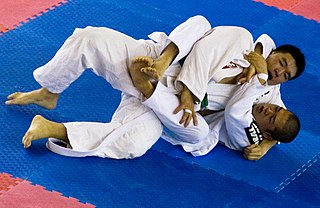
In combat sports, a spinal lock is a multiple joint lock applied to the spinal column, which is performed by forcing the spine beyond its normal ranges of motion. This is typically done by bending or twisting the head or upper body into abnormal positions. Commonly, spinal locks might strain the spinal musculature or result in a mild spinal sprain, while a forcefully and/or suddenly applied spinal lock may cause severe ligament damage or damage to the vertebrae, and possibly result in serious spinal cord injury, stroke, or death. Spinal locks and cervical locks are forbidden in IBJJF Brazilian jiu-jitsu competitions, amateur mixed martial arts (MMA), multiple forms of no Gi jiu-jitsu, judo, and other martial arts. However, professional MMA and some Brazilian jiu-jitsu competitions do permit spinal locks and, particularly, neck cranks, and such moves are trained in various MMA and Brazilian jiu-jitsu schools.

A soccer kick, also known as a soccer ball kick or PK in puroresu and shoot fighting, and as tiro de meta in vale tudo, is a reference to a kick that is similar to kicks used in association football. It is the colloquial term for a kick performed against a prone, kneeling, rising or supine opponent by a fighter who is in a standing or semi-standing position, to any part of a downed opponent. The technique is banned under the Unified Rules of Mixed Martial Arts; however, other rulesets, including the ones used by Pride Fighting Championships do permit them. Soccer kicks have been regularly discussed as to potential damage. There has been a regular debate on the usage of them within MMA. Some MMA fans and fighters support them while a fight doctor and politicians have opposed them.

Cage Rage Championships, also known as Cage Rage, was a United Kingdom-based, mixed martial arts promotion that premiered on 7 September 2002 in London. Cage Rage went into liquidation and is now no longer trading. Cage Rage had been owned and managed by Elite XC until that company ceased operating, and the British promoters behind Cage Rage formed a new organization and withdrew all the old Cage Rage titles. Matchmaker and on-screen personality Dave O'Donnell was also a minority shareholder in the company. Fellow on-screen personality and co-promoter Andy Geer also owned a minority stake until he left the promotion in 2008. Cage Rage events were replayed on Nuts TV, along with their own weekday show on The Fight Network until these channels closed down. Every Cage Rage event and bout is now archived as part of the UFC Fight Pass library.
Most rule sets for mixed martial arts (MMA) competitions have evolved since the early days of Vale Tudo. As a result of health, legal, and moral concerns, many different rulesets were created, which give different countries and promotions very different tactics and strategies. Similarly, shoot wrestling organizations, such as Shooto, expanded their rulesets to integrate elements of Vale Tudo into their sport. However, for the most part, fighters accustomed to one rule set can easily acclimate to the others.

The World Association of Kickboxing Organizations is an international kickboxing organization counting over 120 affiliated countries representing all five continents. WAKO is a major governing body of amateur kickboxing and is responsible for the development of kickboxing worldwide. The organization was officially recognized as an official kickboxing governing body by Sport Accord. WAKO is recognized by the Global Association of International Sports Federations (GAISF) and the International Olympic Committee (IOC).
The Federation of Mixed Impact Martial Arts R-1 is a promotional organization aimed at mixed martial arts "R-1" development and popularization in Russia. The R-1 Federation unites various aspects of martial arts. R-1 rules are based on research into preferences of tournament participants and spectators. The rules are intended to guarantee maximum entertainment. A related product called Combat Time R-1 emerged on the world professional sports arena.
















